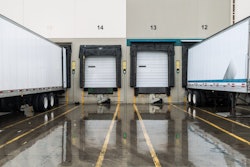
This is the second installment of a two-part series on how the free market responded to the COVID-19 crisis. Part 1 explored pricing volatility experienced by carriers, 3PLs and shippers. This article delves into the hot-button issue of rate transparency.
When negotiating rates, shippers, 3PLs and carriers have access to the same data to track and monitor trends in contract and spot freight markets. The information gives all parties a baseline for rate negotiations and strategic planning.
The ubiquity of data and technology has not eroded the value of trust in relationships that enable all parties to achieve mutually beneficial outcomes, however.
 John Elliott, CEO of expedite carrier Load One said a fixed margin for 3PLs is implausible since they often take losses on some loads but make a higher margin on others while looking at customers on an overall average basis for profitability.
John Elliott, CEO of expedite carrier Load One said a fixed margin for 3PLs is implausible since they often take losses on some loads but make a higher margin on others while looking at customers on an overall average basis for profitability.During a crisis, shippers and 3PLs know they could jeopardize their capacity on a short and long-term basis if their rates go below what carriers need to be profitable, said Gail Rutkowski, executive director of NASSTRAC, a shippers association for transportation and logistics professionals who manage freight across all modes. The association also has 3PL and carrier members.
Because shippers tend to work directly with larger carriers to negotiate freight contracts, their market perspective is different than 3PLs who source most of their capacity from small carriers and owner-operators in the spot market, she said.
Medium and large carriers have a “pretty good feel” for their cost structures, said Jim Ward, president and chief executive of D.M. Bowman, a full-service trucking and logistics provider based in Williamsport, Maryland.
“We are equipped to make good decisions about what rates work for our fleets and what doesn’t,” he said.
Small carriers, by contrast, typically have a group of trusted 3PLs who become their “fund managers” by using market insights and their experience to help smaller haulers maximize the yield on their time and assets, said Anshu Prasad, CEO of Leaf Logistics.
Leaf Logistics is a New York City-based company that developed a freight contracting platform used by buyers (shippers and 3PLs) and sellers (carriers) to secure future transportation capacity, rates and service.
Motor carriers that have a logistics division also benefit from the same type of market insights. The rate negotiations between D.M. Bowman and shippers are driven by carriers’ costs, but the company benefits from having a 3PL division to keep a pulse on market conditions and rates to identify opportunities for the fleet, Ward said.
Most carriers that do business with Intelligent Logistics are small fleets, said Brandon Arnold, vice president of the Austin, Texas-based 3PL. Trust is a very important factor since many small fleets do not have a clear understanding of their costs, he noted.
Hard-earned relationships built on trust can be strained in a volatile market, like the present, when “there is a tendency for [carriers] to chase dollars without considering the impact on long-term relationships with shippers and brokers to retain their business,” he said.
On the other hand, Arnold added, “at this point, everyone is trying to keep their head above water, and there is probably a lot more forgiveness for carriers that need to go do that.”
Alex Steurer, director of operations at ReedTMS Logistics, an asset-based 3PL based in Tampa, Fla., emphasizes the importance of focusing on the entire value equation in rate negotiations with carriers. The equation includes efficiency, utilization, visibility and relationships. Those who approach a 3PL as a trusted partner can benefit by combining head hauls with backhauls and triangulating moves to achieve higher profitability and more predictable freight patterns, he said.
The asset side of the business, Reed Transport, has approximately 100 trucks and 500 trailers.
The quest for transparency
Rutkowski agreed that the cost factors used to determine freight rates make it difficult, if not impossible, for a shipper or 3PL to secure capacity in contract and spot markets like a commodity.
Supply and demand in the freight market also change constantly, with or without a pandemic. Add up these factors and it becomes nearly impossible to develop long-term predictable models for pricing, said John Janson, senior director of supply chain at SanMar Corp., a shipper of custom apparel and accessories.
“The cycles of good times and bad are getting closer together, making the prediction of rates more difficult,” he said. “In addition, no one knows what the new normal is going to be when we come out of the virus situation.”
For 3PLs, establishing a pre-set margin for loads is not a solution for rate transparency. A fixed margin, such as a percentage of load revenue, may not be enough to cover a 3PL’s costs for billing and insuring a local freight move, said John Elliott, CEO of Load One, an expedited transportation and logistics provider based in Taylor, Michigan, with a 400-plus-truck fleet and a 3PL freight management business, ARC Supply Chain Solutions.
A fixed percentage might only work for long-distance freight moves with higher revenue. A fixed margin is also implausible since 3PLs may take losses on some loads while making higher margins on others and look at customer profitability on an overall average basis, he said.
Strengthening relationships
A number of shippers, carriers and 3PLs said they have not only survived the turmoil of 2020, but have used it as an opportunity to come out ahead.
 During economic downturns, the relationships that D.M. Bowman has with shipper and 3PL customers are “strengthened through the value proposition you offer each other,” said Jim Ward, president.
During economic downturns, the relationships that D.M. Bowman has with shipper and 3PL customers are “strengthened through the value proposition you offer each other,” said Jim Ward, president.Based on a recent survey of NASSTRAC members, Rutkowski found that nearly all were committed to paying their freight bills on time and honoring commitments with carriers for lanes and rates.
“I’m not going to say all are doing that, but good shippers know that to maintain capacity they need to stand by their commitments, and a lot have,” she said.
As a shipper, SanMar has focused on working directly with carriers, “knowing that we may slightly overpay some time and may benefit from the rate at other times,” Janson said. “With our most strategic carriers we are talking about a long term contract that would allow for a rate to move up and down based on a percentage of spot activity.”
As a motor carrier, Ward said D.M. Bowman has “worked tirelessly to maintain our network, and provide necessary capacity to service essential customers,” adding this has required the company to increase its volume of spot market freight in order to reposition assets and support those customers.
Mid-size and large carriers generally have contracts with shippers to stabilize their businesses. Small carriers have been hit hardest during the pandemic, said Prasad. Carriers of all sizes have been working to find solutions with shippers and 3PLs that decrease volatility and increase predictability of freight, he added.
By analyzing shipping patterns, Leaf Logistics builds “flex dedicated” arrangements with freight that shippers previously moved in the spot market. For example, a shipper may have 30% of its freight in the spot market, but further analysis may determine that only 10% of that volume are truly spot loads, Prasad said.
“The other 90% has a pattern,” he said. Flex dedicated arrangements are short-term deals that secure capacity for shippers and 3PLs to save money and increase service over spot market transactions.
As a 3PL, Intelligent Logistics has chosen to take less risk and focus on shoring up existing lanes that it has with carriers.
“[Carriers] don’t want volatility either,” Arnold said. “They want consistency to keep their trucks moving and drivers in the seat.”
Reflecting on times when market conditions were as bad, if not worse, than present, D.M. Bowman’s Ward is convinced the free market works best for everyone.
During the downturns of 2001 after 9/11 and the recession of 2007-2009, the relationships D.M. Bowman had with shipper and 3PL customers were “strengthened through the value proposition you offer each other,” he said. “Being able to work together to continue to take waste and cost out of the system, in good or bad times, is what makes a strategic partnership.”












